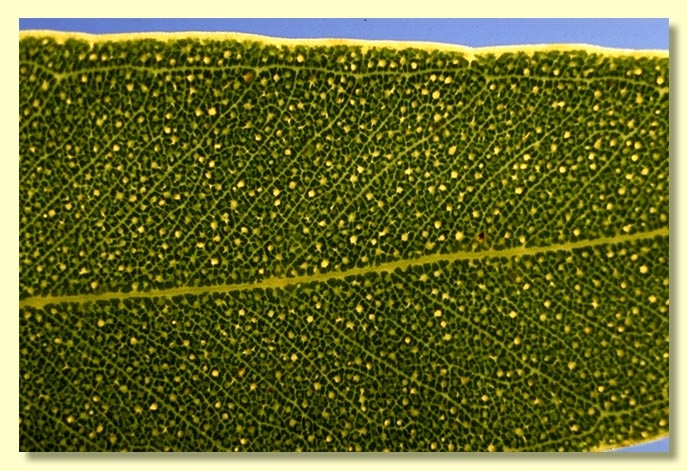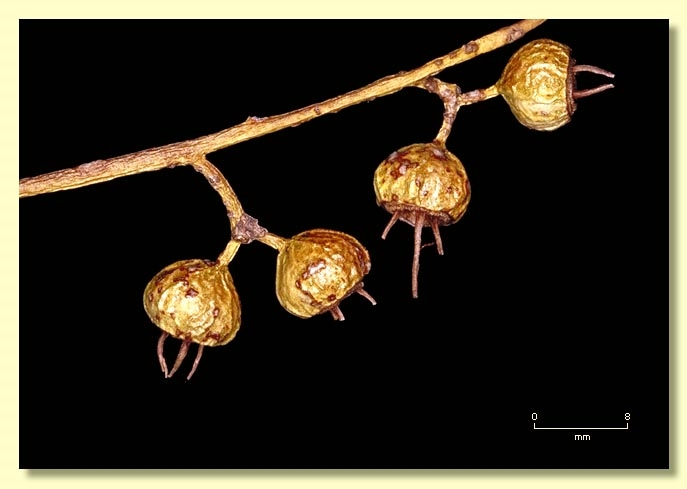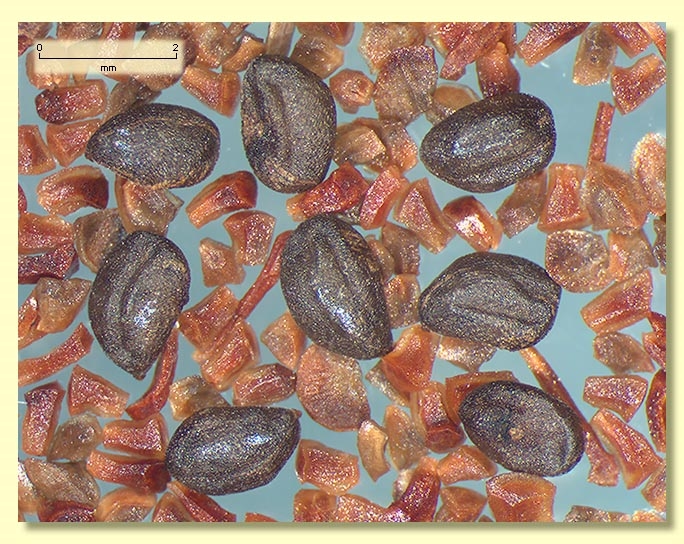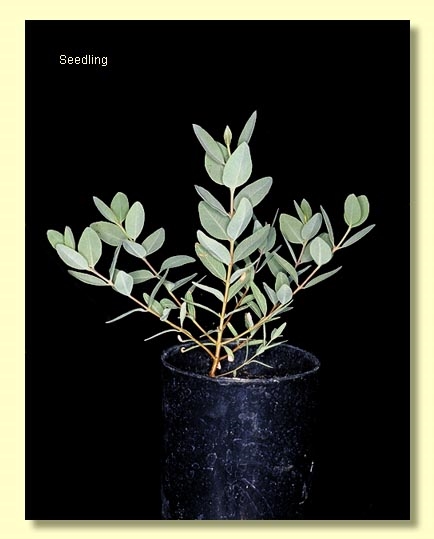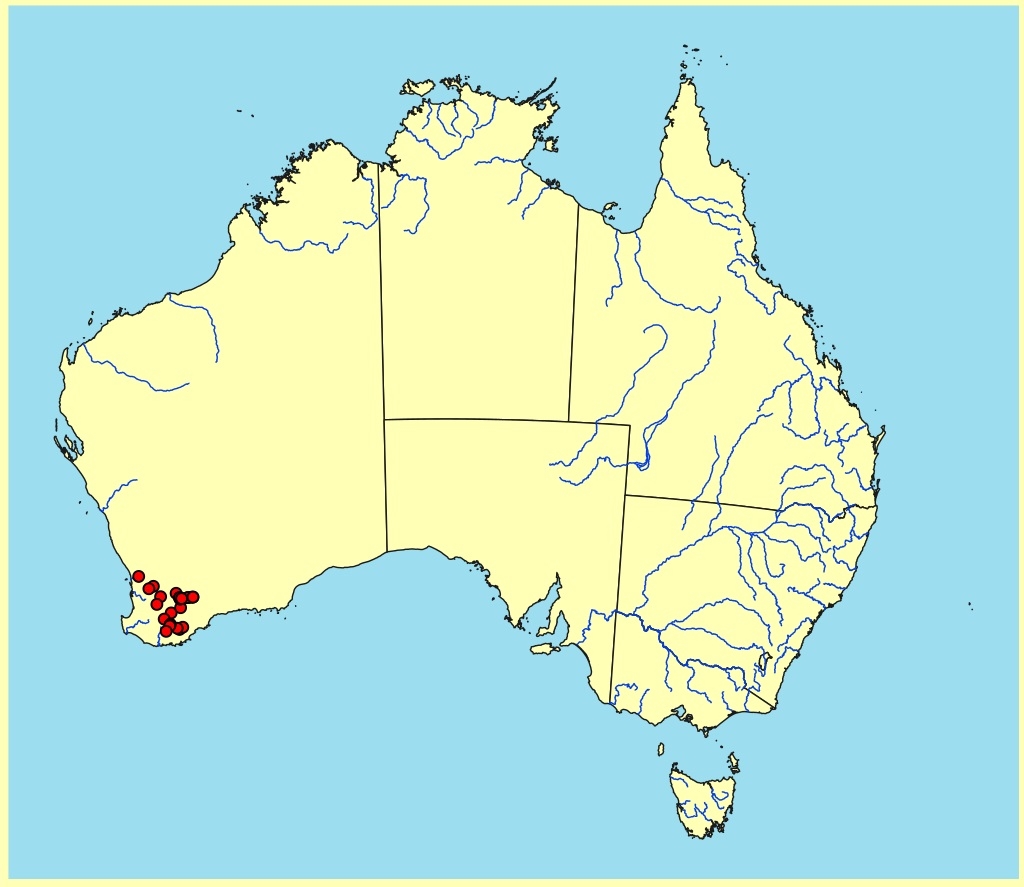Euclid - Online edition
Eucalyptus dorrienii
Eucalyptus | Symphyomyrtus | Bisectae | Destitutae | Falcatae | Rugatae
Eucalyptus dorrienii Domin, Repert. Spec. Nov. Regini. Veg. 12: 388 (1913).
T: Cranbrook to Warrunup, W.A., 1910, A.Dorrien-Smith 7087; holo: PR; iso: K.
[note: for many years there was confusion about the application of type specimens as representatives of plants in the field for both Silver mallees and Silver mallets of south-western Western Australia. The name Eucalyptus falcata Turcz. was thought to represent the Silver mallees widespread from the southern wheatbelt and adjacent foothills to subcoastal Fitzgerald River National Park. Closer inspection of type specimens by Nicolle & French (2012) matched the type specimen of Eucalyptus falcata Turcz. to a more restricted mallet species masquerading under the name Eucalyptus argyphea L.A.S.Johnson & K.D.Hill and the name Eucalyptus falcata Turcz. must replace the name E. argyphea because it was published earlier. The name E. dorrienii Domin was published in 1913 also to represent Silver mallees, and shown to legitimately be a representative of those Silver mallee plants, therefore replaces the name Eucalyptus falcata Turcz. for them.
For further discussion of the types see Nicolle & French (2012) through this link:
http://florabase.dpaw.wa.gov.au/science/nuytsia/653.pdf ]
Mallee to 5 m tall. Forming a lignotuber.
Bark smooth throughout, silvery grey and green-grey over pale brown-orange.
Branchlets lacking oil glands in the pith.
Juvenile growth (coppice or field seedlings to 50 cm): stems rounded in cross-section; juvenile leaves always petiolate, opposite for several nodes but soon alternate, ovate, 3.5–6 cm long, 2–3 cm wide, green or grey-green.
Adult leaves alternate, petioles 1–1.8 cm long; blade lanceolate to falcate, 6.8–10.7 cm long, 0.7–1.6 cm wide, base tapering to petiole, margin entire, apex pointed, concolorous, maturing glossy dark green, side-veins at an acute or wider angle to midrib, reticulation dense, intramarginal vein close to margin, oil glands intersectional or fairly obscure.
Inflorescence axillary unbranched, peduncle slender and pendulous, 0.6–1.6 cm long, buds (7)11 to 19 per umbel, slender pedicels 0.3–1 cm long sharply defined relative to the truncate base of bud. Mature buds ovoid, 1–1.5 cm long, 0.5–0.7 cm wide, the operculum 2 to 3 times the length of the hypanthium which is often dilated below the join, and always visibly but shallowly ribbed, scar present (outer operculum lost early), operculum conical and elongated but not or scarcely ribbed, stamens inflexed, anthers cuboid, versatile, sub-basifixed, dehiscing by longitudinal slits, style long and straight, stigma blunt, locules 3 or 4, the placentae each with 4 vertical rows of ovules. Flowers creamy white or rarely yellowish green.
Fruit pendulous, pedicellate (pedicels 0.3–1 cm long), flattened-globose, 0.4–0.9 cm long, 0.7–1 cm wide, ribbed to weakly so, rim thick, disc more or less level, valves 3 or 4, slender and prominently exserted but fragile and easily lost.
Seeds dark grey-brown to brown, 1–2 mm long, ovoid or flattened-ovoid, dorsal surface smooth to very shallowly reticulate, hilum ventral.
Cultivated seedlings (measured at node 10): cotyledons Y-shaped (bisected); stems rounded in cross-section; leaves opposite for up to 14 nodes, sessile at first, becoming shortly petiolate, initially linear then narrowly elliptical for ca 7 to 12 nodes when they become ovate or occasionally orbicular, 2–4 cm long, 1–2.5 cm wide, base tapering to rounded, margin entire, apex rounded to acute, green to grey-green, dull.
Flowering has been recorded in January, February, June, August, October, November and December.
A mallee endemic to Western Australia, found in the southern wheatbelt and adjacent foothills to the west, in an area bounded by Beverley, Mount Barker, Pingrup, and Lake Grace. The bark is smooth and the adult leaves glossy dark green, with pendulous umbels of conical ovoid shallowly ribbed buds on slender pedicels.
In his classification of the eucalypts Brooker (2000)placed Eucalyptus dorrienii (as E. falcata ) in Eucalyptus subgenus Symphyomyrtus section Bisectae subsection Destitutae because buds have two opercula, cotyledons are Y-shaped and branchlets lack oil glands in the pith. Within this subsection E. dorrienii belongs to a group of species and subspecies characterised by down-turned or spreading inflorescences with pedicellate ovoid buds with a conical to beaked operculum, flattened-globose fruits with exserted fragile valves, and adult leaves that are green, densely reticulate and have numerous intersectional oil glands. This group is series Falcatae subseries Rugatae and has been considerably modified since Brooker's published classification. The species now included in subseries Rugatae are: the mallets E. falcata, E. ornata, E. purpurata, E. recta, E. rugulata and the recently described E. annettae, and the mallees E. dorrienii, E. petrensis, E. opimiflora, E. ecostata, plus E. goniantha (with 2 subspecies), E. semiglobosa, E. notactites, and E. kessellii (with 2 subspecies) .
Within subseries Rugatae the mallee E. dorrienii differs from the mallet species mentioned above by profoundly different growth habit.
Of the mallee species in subseries Rugatae, E. petrensis, a sprawling mallee, differs from E. dorrienii in having spreading to erect, not pendulous, inflorescences with shorter pedicels and peduncles, weakly ribbed buds and fruit, a more beaked operculum and a restricted habitat on outcropping coastal limestone from Seabird south to Mandurah. The newly described mallee E. opimiflora, which occurs in the northern and central wheatbelt from Mingenew south to Cunderdin, differs from E. dorrienii in having smaller umbels on short erect to spreading peduncles, shortly pedicellate weakly ribbed to smooth stout buds and fruit. To the south-east of the distribution of E. dorrienii the species E. ecostata occurs in gently undulating sub-coastal to coastal mallee and heath. E. ecostata differs in having virtually unribbed buds and fruit, but is otherwise very like E. dorrienii.
The remaining mallees in subseries Rugatae all occur in southern coastal or subcoastal areas, and differ from E. dorrienii thus: E. goniantha (squared branchlets, flat peduncles, stout cream ovoid buds which are weakly ribbed or not ribbed, in 7s or 9s), E. notactites (squared or winged branchlets, flat peduncles, stout cream ovoid buds weakly ribbed, in 7s up to 19s), E. kessellii (broad flat short peduncles, stout cream ovoid ribbed buds in 3s or 7s), E. semiglobosa (pendulous umbels on slender scarcely flattened peduncles, cream rounded buds with rounded short operculum, not or weakly ribbed, in 7s, 9s or 11s). The more distantly related E. cooperiana has spreading or pendulous slender peduncles, white ovoid-cylindrical buds with short usually flattish operculum, unribbed or only weakly so, in 9s, 11s or 13s.



